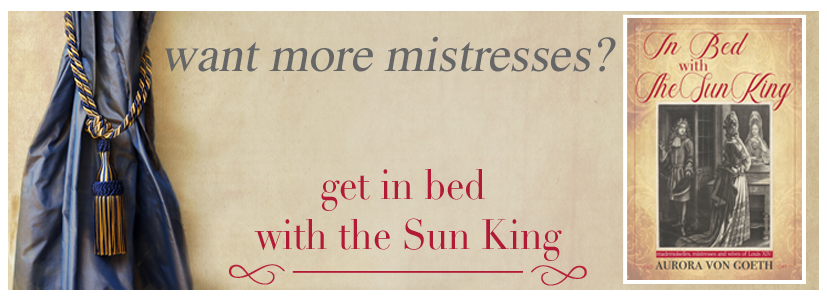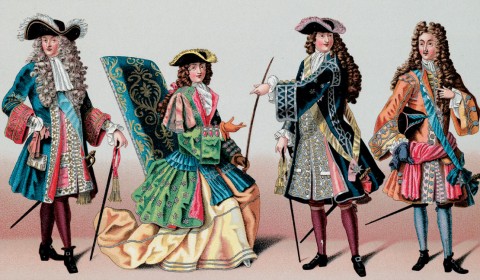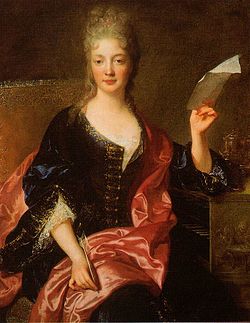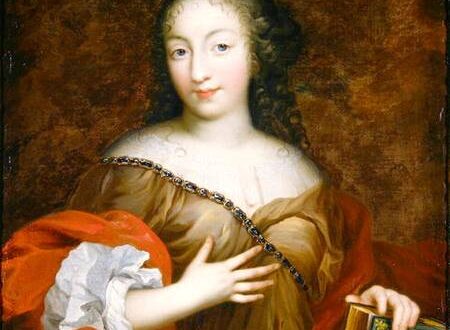Henriette d’Angleterre
Henrietta of England was born on 16 June in 1644 at Bedford House in Exeter at the height of the English Civil War. Her mother Henriette-Marie de France, daughter of le bon roi Henri, who had married Charles I of England on 13 June in 1625, lived at Oxfort with her husband during the autumn of 1643. But as, by early 1644, Oxfort was not considered safe anymore, it was decided the pregnant Henriette-Marie should travel south to Bath to await the birth of their child there. Charles I accompanied his wife until Abingdon was reached, before he turned back en route to Oxfort. It was the last time both saw each other.

As Bath was reached, Henriette-Marie only stopped for a brief time and continued to Exeter instead, arriving there on 1 May in 1644. By then it was feared that Henriette-Marie might not survive this pregnancy… and on top of it, the Parliamentarian generals the Earl of Essex and William Waller came up with a plan to kidnap her. Waller was to distract Charles and to keep his forces busy, while Essex would strike south to Exeter with the aim of capturing Henriette-Marie in order to use her as a bargaining chip.
The Earl of Essex reached Exeter by June and Henriette-Marie’s labour began. It was another difficult birth for her.
It left her weak, in much pain and in considerable distress. Essex was drawing closer and closer at the same time. To avoid being taken captive, Henriette-Marie left her newly born daughter in Exeter and fled the town. The risks of taking the baby with her were too great. Henriette-Marie managed to reach the coast and boarded a Dutch vessel to seek refuge in France. Her ship came under fire from a Parliamentarian ship, but she urged the captain to continue the voyage and eventually reached France.
All the while, her daughter was in the care of Anne Villiers, then known as Lady Dalkeith, and in delicate health. She fell ill with convulsions as she was not yet a month old. On July 26, the little girl met her father for the first time. Prior to the meeting and due to her weak health, Charles ordered her to be baptised in accordance with the rites of the Church of England and the little girl received the name Henrietta after her mother.
In the meanwhile, Henriette-Marie tried her best to gain the support of France for her husband. Support he was in dire need of, for the royal troops were in distress. And then Lady Dalkeith was forced to move with the little princess Henrietta to Oatlands Palace, outside London, and pressured to hand the child over to the Parliament. She refused, but it dawned on her that the child might be taken from her at any moment and she could not do much about it… fearing for the very life of the little princess, Lady Dalkeith arranged for their escape from England. Dressed up as a peasant woman, and pretending Henrietta was her son, she managed to get out of London in summer 1646 and boarded a ship to France. Both arrived safely.
While France granted them protection, it could not do much more for them. France had to deal with its own civil war, the Fronde. And so, Henriette-Marie could not count too much on the relatives to help her out, even though she was the aunt of the Boy-King Louis XIV and sister-in-law to his mother.
Upon Henrietta’s arrival in France, she and her mother were given an apartment in the old and gloomy Louvre, the permission to use the Château de Saint-Germain-en-Laye and a monthly pension of 30,000 livres. The latter was a rather large sum, but much of it was sent to England in order to aid Charles I or to help his cavaliers to reach the safe shores of France.

The little princess Henrietta became known at the French court as Henriette d’Angleterre, or the Princesse d’Angleterre, and remained in the Louvre with her mother as the Fronde swept over France. Her first years in France were quite rough ones. The monthly pension became smaller and smaller, the winters were cold, so cold that both sat shivering by the fireplace together, so cold that it hurt. They lived very sparingly, were not in possession of warm clothing or could dress according to their ranks.
The fallen Queen of England had to sell her jewels and the few things she managed to take with her from England in order to keep them at least a little comfortable. Nobody cared much for mother and daughter. They were of royal blood, but poor and nobody really thought the Stuarts would sit on the throne of England again. Especially so, as the news of Charles I execution reached Paris. Henriette-Marie was now an exiled dowager Queen, without any means, her son Charles was a King without a crown, and her daughter a royal princess whose whole family was dependant on the good will of their relatives… and the relatives did not care much about them.
Henriette-Marie decided to have her daughter brought up in the Catholic faith and the princess entered the Couvent des Visitandines de Chaillot. As the Fronde was over, things got a little better for mother and daughter. Both moved from the gloomy Louvre to the more pleasant Palais-Royal, where also Anne d’Autriche and her two sons resided. They were still not of too much importance to anyone, but at least their living conditions became better. As a bit of a thank you, the young princess received the second name Anne in honour of Anne d’Autriche.
And so life continued. Henriette-Marie was soon surrounded by English royalists seeking refuge in France. She became more and more depressed and increasingly focused on her little girl, which she called Minette. As Minette was old enough to attend court entertainments, her mother always kept a close eye on her. During one of those entertainments, a ball, Anne d’Autriche told her son to be polite and ask his cousin for a dance…. but Louis was not at all fond of the sickly girl and refused, causing a bit of a scandal because he did not want to dance with this uninteresting “little girl” when he could dance with someone more interesting instead, like a Mancini for example.
Like Louis, Philippe did not care much about that strange English princess either. In 1658, la Grande Mademoiselle, daughter of Gaston de France, and thus first-cousin to Minette, upstaged the latter at court. Mademoiselle was reprimanded for it by Mazarin and Philippe rushed to her defence: “And so if Mademoiselle did do it, would she not have been right? We have come to a fine state of affairs when people like that (Minette and her mother), who owe their bread to us, go in before us. Why don’t they go live somewhere else?”
Although there was obvious disinterest on Louis’ side, and also that of Mazarin, who was not really a Stuart friend and even tried to win the support of Cromwell, Henriette-Marie entertained the thought that her Minette could marry Louis XIV and become Queen of France. Wishful thinking, because in all the years they had already spent in France, over ten by then, Henriette-Marie did not really manage to interest anyone in marrying her daughter. This did not change until her son Charles won the throne of England back. While nobody really cared for them in the past, Henriette-Marie was now not just an exiled dowager Queen and mother of a King without Kingdom anymore. Her son did what many thought impossible and changed the fortune of them all. Her brother’s success meant also a raise of status for Minette, after all she was now sister to a proper King. … but by then it was too late for Minette to become Queen of France. It had already been settled that Louis XIV would marry the Infanta of Spain, but at least Anne d’Autriche took a sudden interest in Minette now and tried to involve her more in family matters… if Henriette-Marie permitted it.

After Louis got hooked, it was time to find a bride for Philippe and Philippe took in mind to marry his English cousin. He told Mazarin of his desire to marry Minette in 1658 already, a couple of months after the above mentioned incident with la Grande Mademoiselle. Philippe was rather eager to get married as soon as possible, not because he liked the bride that much, but because as married man he could finally fully claim his inheritance and gain a little independence from his brother and mother, but he had to wait for a while. Much to his displeasure.
On behest of Philippe, the matter was brought forward to all involved. Charles II agreed fairly quickly, thinking it would be a fabulous match for his favourite sister. Louis agreed too, for it would bind Charles and England to France again. Henriette-Marie was strongly in favour of it, after all Philippe was at that point heir to the crown of France and would ensure a safe future for her daughter. For Philippe himself, the match was a rather logical one. He knew Minette since childhood, he knew her character, or so he thought, they got along, at least better than he got along with others, and she most likely knew… Knew that his real love was a handsome young man.
For Minette, the whole thing was quite good too. She could remain in France, the only home she knew, and would not have to move to a country strange to her as royal princesses usually had to do. There was no need to learn a different language or to adjust to different customs. She knew the groom quite well and knew his family, was part of that family. It would also mean that her mother, who had gotten annoyingly pious and strict by then, would have no say over her anymore. She could wear pretty gowns, something she never really had, and jewels. She would have her own household, own ladies-in-waiting, she would be Queen in this household… and she might even be able to challenge that Spanish Infanta, who wasn’t really pretty nor graceful. She might not be Queen of France, an idea to her liking introduced to her by her mother, but she could act Queen at least.
Henriette-Marie took Minette to England with her, intent to sort out their business and secure a dowry for her daughter, (Also to keep her son James, Duke of York, from marrying Anne Hyde, a former lady-in-waiting to Mary, Princess Royal.) While in England, the French court officially asked for Minette’s hand on 22 November 1660. Charles II agreed to give his sister a dowry of 840,000 livres and a further 20,000 towards other expenses. She was also given, as a personal gift, 40,000 livres annually and the Château de Montargis as a private residence. Their return to France was delayed several times, first by Minette falling ill, then by the death of her older sister Mary. Mother and daughter did not embark until January 1661 and by the time they arrived in France, Cardinal de Mazarin was close to death, thus the marriage was put off for a while. After Mazarin died, the court went into full mourning and it took another tree weeks for the marriage to finally take place. Due to the court being in mourning for Mazarin, and Minette in mourning for her bother, who had died in September 1660, and her sister, the ceremony was rather small.
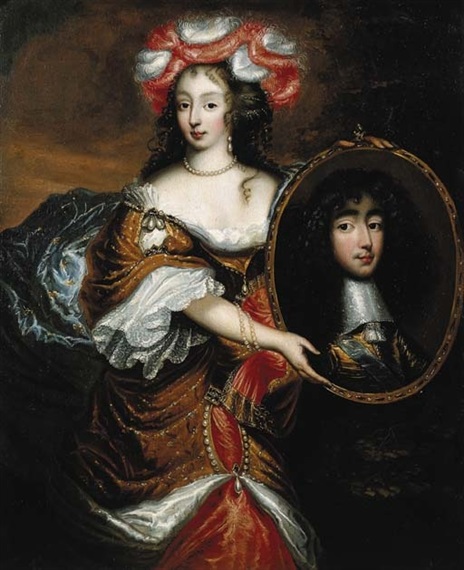
On March 30 in 1661, groom and bride went to confession and afterwards watched how their marriage contract got signed by Louis XIV, his wife Marie-Thérèse and Henriette-Marie. The following day, both were married in the privat chapel of Henriette-Marie at the Palais-Royal. Afterwards a small supper was given by Henriette-Marie and that was it.
Henriette d’Angleterre was now Duchesse d’Orléans, a daughter of France, or simply Madame after the traditional form of address, Monsieur, for the King’s brother. She was now, next to the Queen and the Queen-Mother, one of the most important women in France.
The wedding night was disappointing, at least for Philippe. He was eager to get going, but as he was about to do that he was told Madame had a visitor. Monsieur le Cardinal showed up. Not an actual Cardinal, it was a phrase used for menstruation. So, he left in a foul mood and the second try was not more successful, for he did not feel able to perform to full satisfaction… (For more on Monsieur and his marriages click here.)
The newly weds moved into the Tuileries and busied themselves with setting up their households. Madame needed servants, ladies to attend to her, a selection of gowns and jewels and an apartment worthy of her. Philippe fulfilled her every wish and treated her as a doting husband would, but that changed soon. Henriette d’Angleterre did not really exactly match the beauty standards of the time, she was way too thin, sickly, and her face too long, but she made up for it with charm, wit and grace. Her new expensive toilette did the rest and skilfully hit her hunchback, which even Philippe did not know of until after the wedding. Minette rose from someone nobody cared about, to the brightest shining jewel of France… and that, of course, attracted flattery and flirting. While husband and wife had some things in common, like a strong dislike for outdoor activities like hunting (Minette was a good equestrian and showed it on several occasions, but her state of health made it too exhausting for her) and sunlight and a love for jewels and everything pretty, a bit of a dislike for each other grew soon.
Monsieur was not really interested in the charms his wife was praised for and he did not care about intellectual matters either. Nor did he care at all for her physical charms. But others did and these others soon swarmed around Minette day for day, like moths attracted to her light. Among them the certain handsome young man Philippe gave his heart. And another gentleman of quality began to show an interest in the new Madame, it was the King. Louis XIV resided at Fontainebleau with parts of the court, his mother and his wife. The latter was pregnant and somehow that made her even more dull company than usual. So, why not invite his brother and that Minette everyone talks about?
The King received daily reports from Paris, all of them praising the new Madame and how she was the star of every entertainment. His company was quite boring, thus he invited Monsieur and Madame to join him in the country. It was the end of April as Monsieur and Madame left Paris, and with them their whole household and entertainments, to join the King in Fontainebleau. Their marriage would never recover from this visit.
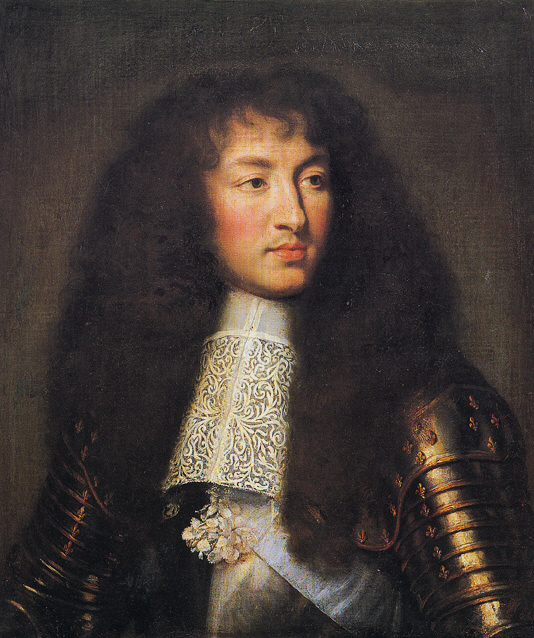
Louis, in the prime of handsomeness, was immediately taken with Minette… and that was a bit of a surprise for him, because she was so very different from how he remembered her, that little girl he did not want to dance with. As Philippe introduced Louis to the idea of getting wedded to Minette, Louis joked he can not understand how his brother could possibly marry that girl. “Brother, you are marrying the bones of the Holy Innocents!“, he said, comparing Minette’s slender figure with the bones that can be found on the Cimetière des Innocents, the largest cemetery of Paris. That Louis remembered Minette as that little girl and not the woman she had become in the meanwhile, shows how Minette was kept away from court before her marriage and that both brothers did not have much to do with her previously, apart from seeing her at some entertainment every once in a while.
What Louis saw as Madame arrived enchanted him at once. She was pretty, witty, elegant, charming and smart. She was a woman, but had a sort of childlike innocence about her some times and other times, she was rather coquettish in a coy way. Her lifestyle was a bit strange: never sleeping much, never resting more than an hour, always in search for something to amuse, unsettled, of delicate health, nervous and unfocused. She never ate much either and Louis disliked that in women… but all in all, she was the perfect distraction for him from the strict mother and dull wife.
Thus Louis made sure his sister-in-law was always close to him in that summer of 1661. They promenaded together, enjoyed baths in the river, explored the grounds and had long moonlight strolls accompanied by the sound of violins, danced or engaged in lively conversation in the many salons of the chateau… and exchanged many longing glances. How far the whole thing went, only these two know. By law, a sister-in-law was just like a real sister… but Louis might not have cared much about that. And Minette was not as innocent as she pretended to be either. She already had a reputation for flirting, much to the displeasure of her husband, and that flirting had already caused a scandal. As she was on the way to England, on a vessel commanded by Admiral Montague, the Duke of Buckingham and Admiral Montague, both infatuated with her, were close to exchange blows. Back in France, the Duke of Buckingham hardly ever left Minette’s side, which forced her future husband to have his mother send the Duke back home to England. Before those two felt enchanted by Minette, the Duke of Monmouth, her nephew, fell for her.
Now the King was very attentive to Minette and whatever went on, it was enough to have the whole court gossip about how the King acted so gallant with Madame, it seemed he was in love with her, and she with him. Monsieur, who always had to give in to his brother, was outraged and flew into a fit of jealousy. After all his brother had already taken from him, he now seemed to claim the one thing that was supposed to be his own, his wife.
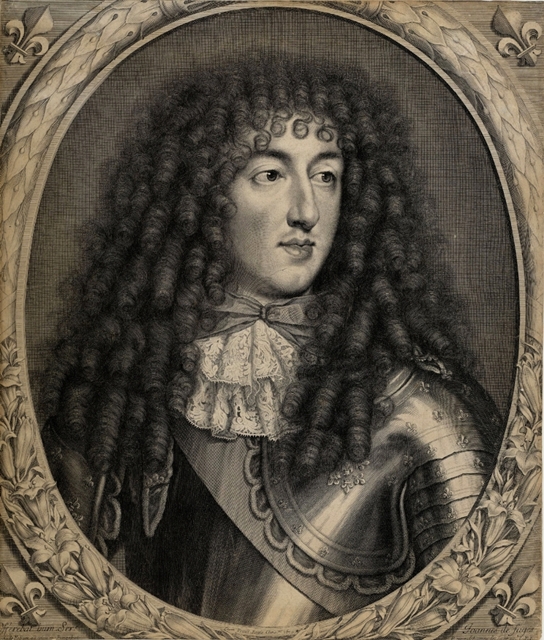
Again, Philippe had to get their mother involved. What else could he do? She was the only one Louis would listen to and the only one who could make him feel guilty. Not just guilty about the whole being gallant thing, but also guilty about being gallant while the Queen was with child and how their being gallant in public made Philippe look like a fool.
It worked, but instead of ceasing to be gallant with each other, the King and Madame took to being gallant in a more private setting and in order to distract the general public from it, Minette and her friend Olympe came up with a plan. Louis was to act as if he would court one of Minette’s demoiselles d’honneur and by doing that, make everyone believe he was visiting Minette to see the girl in question. Thus he could spent as much time as he pleased in Mintette’s company, as long as he would cast the occasional desirous glance at the girl in question. After some consideration, Louis decided for a province girl. Perfect, for the girl was shy, plain and dull. Thus would be no trouble for Minette. But then after a while of pretending, Louis actually started to like that shy, plain and dull girl. Her name was Louise de La Vallière and she was so very different from Minette. In fact, the very things Minette thought so very uninteresting about Louise, were the ones which now captivated Louis. And soon Louis was really visiting Minette to see Louise and not Louise to see Minette, as it was planned.
Louis interest in Minette did not even last a whole summer, but it destroyed a marriage that started out as a happy one forever. Although Louis was now being gallant with Louise, Philippe remained highly suspicious of his wife. The situation he was in, was frankly ridiculous. His own brother engaged in scandalous public behaviour with his own wife and that wife was now pregnant. Talk had it, the father of the child could be found on the throne. Was that child really his? Or was it that of Louis? There was no way for him to know… and then it became even worse.
Madame, who was so very much admired by everyone, but not so much by the one person she wanted to be admired by anymore, got jealous in turn. Minette could not understand how that Louise managed to steal the King away from her. That girl was so very unworthy of him.
Thus Minette launched a round of intrigues together with Madame de Soissons, herself a former love interest of Louis XIV as well. They all failed. The King was more in love with his Louise than ever before. So, why not make him jealous? Shortly after their marriage, Monsieur had asked Madame to show some kindness to the handsome young man he fancied, the Comte de Guiche, and while Madame did not think too much of that man in first, this changed as Guiche engaged in more and more flattery with her. The attentions he bestowed upon her were discreet, but there. Once the King started to show an interest, Guiche backed respectfully away, but she would have little difficulty to draw him closer again. After all, she was still the jewel of the court. And that is what happened and sent Monsieur into another rage. First his brother and now his lover.
It took a while until Monsieur noticed what was going on, for the whole thing was quite discreet in first. Guiche was present in Madame’s salon, as usual, they talked, but not so much to raise suspicion. They danced in a ballet together, but that was nothing unusual either. But then Guiche also began to visit her in private, while Monsieur was otherwise engaged.
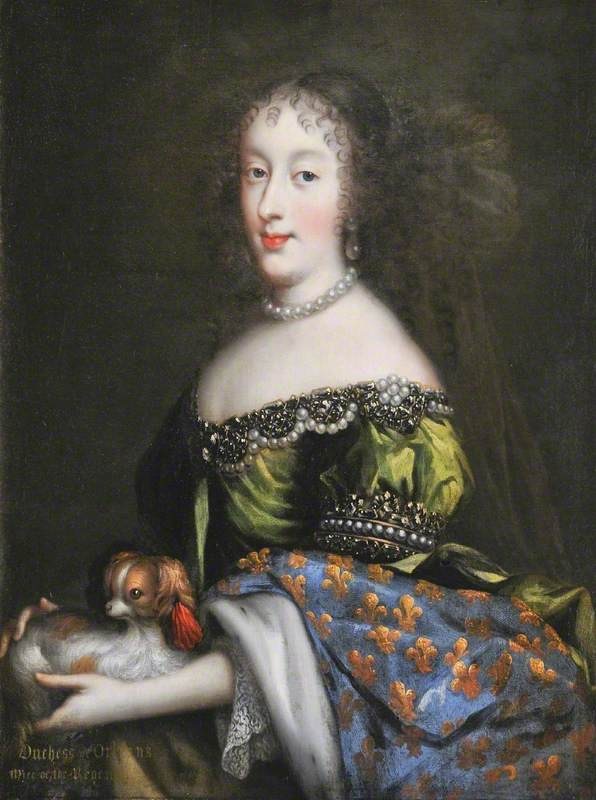
Towards the end of 1661, Monsieur and Madame returned to Paris and resumed the sorting out of their households, which had been interrupted by the King’s invitation. Louis gave them permission to use the Palais-Royal, but that needed serious renovations first, thus the couple settled in the Tuileries again until they could move into the Palais-Royal in 1662. There, on March 27 in 1662, their first child was born. A daughter, Marie-Louise, who would become Queen of Spain one day.
It seems Minette was a little disappointed the child was a girl and not a boy, for she wanted to “jeter à la rivière” – throw her into the river.
After the brief interruption of childbirth, Monsieur and Madame returned to their daily routine and routine of hosting entertainments. Like the Tuileries before, the Palais-Royal became the centre of courtly entertainments. Louis XIV was a frequent guest as well, he was still making merry with his Louise… straight in front of Minette. Also Saint-Cloud, Monsieur’s residence just outside of Paris, saw many festivities. In case of Monsieur, all of that was a welcome distraction, for Minette was still going strong with the flirting and their house slowly but surely turned into a battlefield. Monsieur versus Madame, bound in a loveless marriage.
Nevertheless duties were performed and Minette became pregnant again. On July 16 in 1664, Minette gave birth to their first son. The little boy, named Philippe after his father, lived only for two years. In July 1665, Minette gave birth to a stillborn infant and suffered miscarriages afterwards. On August 27 in 1668, she gave birth to their last child. Another daughter, Anne-Marie, who became the first Queen of Sardinia. Minette did not show too much interest in her children, partly because it was quite unfashionable, partly because there were other things to do. Especially entertainments and Monsieur hosted a lot of them during the 1660’s, each better than the one before and so elaborate and decadent that the Gazette and Mercure lacked words to describe their gloriousness properly.
Madame shone brightly during all of them, dressed in the finest gowns and decked out with diamonds. After each of them, although the pregnancies and miscarriages took a toll on her looks and already weak health, she was praised and admired. The admiration of Guiche was rather obvious by then as well. So obvious, that Louis XIV got wind of it and asked his Louise what was going on. Louise knew it all, but refused to tell, which led to the first big argument between them and Guiche being exiled. Not just because of the whole Minette thing, Guiche also dared to ogle Louise. Minette’s flirtation with Guiche began in 1661 and lasted until Guiche was exiled in 1665, but he was not the only one captivated by Madame’s charms.
After Louis XIV and Guiche, there was François VII de La Rochefoucauld, a good friend to the King. There was Louis de Lorraine aka Monsieur le Grand, another very good friend to the King. His attentions towards Madame nearly ended his own marriage. The Marquis the Vardes was eager to take Guiche’s place and even a member of the clergy, the Archbishop of Sens, showed quite an interest. So did Louis-Henri de Pardaillan de Gondrin, Louis de Rohan-Montbazon and the future Duc de Lauzun.
It became a bit of a hobby for some courtiers to note every glance Madame received, every glance she returned and every fit of anger on Monsieur’s side it resulted in. The whole court talked about those flirtations, about lovers hidden behind screens when Monsieur surprisingly visited Madame and how the gentlemen secretly entered her chambers disguised as servant women or left those chambers via the windows. In summer 1668, the whole thing reached new heights. The Duke of Monmouth was residing in France and rather bold in the display of his affections for Madame, who was rather flattered by it all. As Moliére’s George Dandin was then performed at Versailles, half the court was openly laughing about Monsieur, whose wife was cuckolding him. Monmouth had to leave the court the next day. (George Dandin is a rich peasant, who married the daughter of a poor nobleman, in exchange for some money, and bought himself a title afterwards. The daughter married him against her will and sees herself thus not inclined to act as a good wife should, instead she flirts and makes merry with other gentlemen. George asks his parents-in-law to help him and call their daughter to reason, but they just make fun of him. As does his wife, his servants and the court. The latter because Monsieur George is unable to keep his wife from flirting. The play has no happy end, for the wife and her lover treat him worse and worse, until he considers to commit suicide because with such an evil wife, it is the only thing to do in his opinion.)
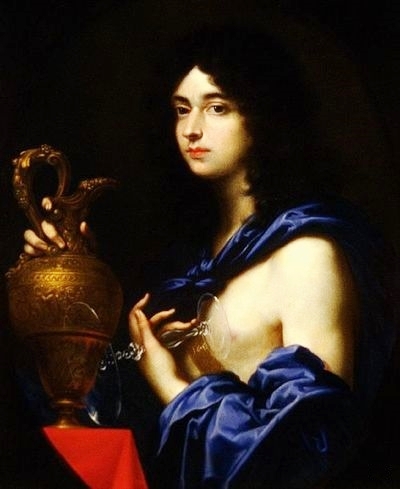
So, there they were. Caught in an unhappy marriage with no escape. Monsieur accusing Madame to have lovers, Madame accusing Monsieur to treat her unfairly. The situation grew more and more tense… and then the Chevalier de Lorraine entered the game. He encouraged the humiliated Monsieur to make an end to Madame’s flirting. Thus spies were installed in her household and the Palais-Royal became the home of intrigues.
Minette did not care much for the Chevalier in first, but as he became more and more important to Monsieur, and in turn Monsieur became more and more distant from her, she changed her opinion and tried to gather her own forces… and that was not an easy task. As Monsieur’s wife, he had full control over her household, including who served in it and on what money was spent. Madame also had to follow Monsieur wherever he went, no matter if she wanted or not, and she had to ask for his permission first, before she could go somewhere without him. In the past, Monsieur had not been too strict with all of that, but this changed slowly but surely now.
Of course, Madame was not pleased by that at all. Nor did she had many supporters in her camp. Most of the courtiers sided with Monsieur, after all he was the one who could dismiss them with an elegant wave of a be-ringed hand and without much of a reason. Minette could not trust her ladies and maids too much either, because quite a few acted as spies for the Chevalier, in some cases unknown to her…. and if the ladies and maids did not want to play along, Monsieur had them replaced with someone more willed. She could not count on the Comtesse de Soissons or the Princesse de Monaco either anymore, both distanced themselves from her. The Comtesse did so because Madame was involved in the exile of Monsieur de Vardes, who was the lover of the Comtesse. The Princesse, who was a good friend to Madame, did so because she actually liked the Chevalier, which led to plenty of arguments between them.
The only one Madame could count on was Daniel Cosnac, the former confessor of her husband. Monsieur Cosnac fell in disgrace, because he failed to talk the King into granting Monsieur a governorship and rushed to Madame’s aid as a rather indecent pamphlet about her affair with Guiche made the rounds. Afterwards he swiftly lost importance for Monsieur, because the Chevalier took over his responsibilities and did it way better than Cosnac.
On behest of Madame, who considered herself to be treated poorly by her husband, Cosnac attempted to get Monsieur to make peace with his wife… and to dismiss the Chevalier. The latter was a big mistake, for the Chevalier had little difficulty to finish Cosnac off afterwards. He acquired some letters, most likely forged ones, and presented them to Monsieur, who might have known they were forged, which said Cosnac was plotting to have the Chevalier removed from Monsieur’s presence. Cosnac was thus stripped of all offices he held in Monsieur’s Household and ordered to relocate himself to his diocese in Valence. Madame protested furiously, but in vain.
The whole thing was especially bitter for her, because Cosnac was apparently in possession of letters written by the Chevalier and of a compromising nature. Those letters left with Cosnac and Madame needed to come up with a plan to get hold of them. By the means of Madame de Saint-Chaumont, someone she could trust, Minette remained in contact with Cosnac and it was agreed that the latter would sneak into Saint-Denis, where they would then meet and he could hand her the letters. A visit to Saint-Denis, where her mother was buried, was something Monsieur could hardly deny her… but the whole thing went terribly wrong.
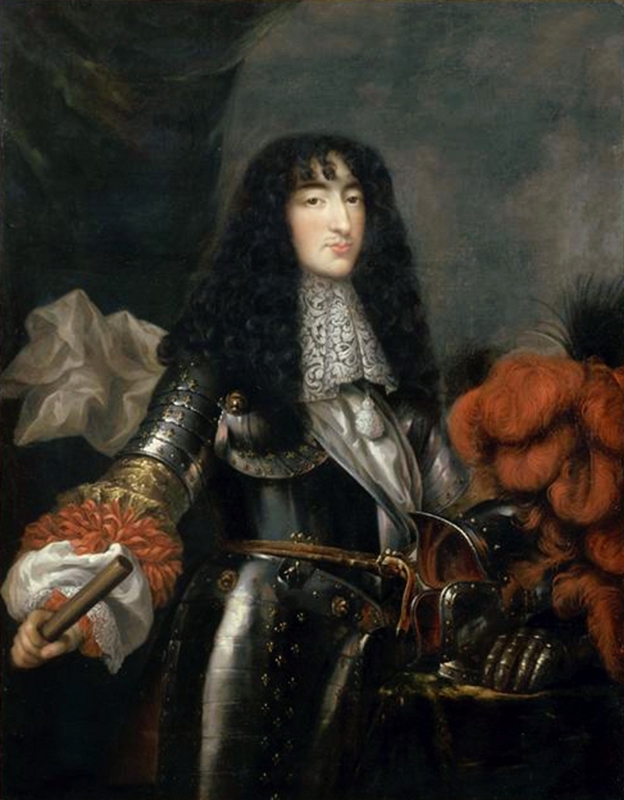
Cosnac was recognised before he could meet Madame and seized. He was exiled once more and Madame de Saint-Chaumont along with him, for a letter written by her was found on his person. What about the Chevalier letters? Cosnac said he managed to hide them before he was seized.
Madame protested once more and again in vain. She urged the King to get involved, but he said he will not interfere in matters of his brother’s household. So, she turned to her brother, Charles II, and told him all about how badly she was treated in long letters. Both of them exchanged letters nearly every week, in which they talked of all sorts of things. Charles wrote in English, Minette replied in French, for her English was as bad as the French of the Queen. Her brother teased her about her many admirers, jested with her, or encouraged her not to give in to the “fantastical humours” of her husband. Meaning the fits of jealously her husband had due to the many admirers of his wife. Charles saw Monsieur, thanks to Madame’s letters, as some sort of good-for-nothing and a pervert that chased after young boys…. but Charles could not do much either to help her… yet. Monsieur had won the battle, but the war was far from over.
Minette had clearly the weaker cards in this game, but this changed as she once more became important to Louis XIV. The King and his Ministers were secretly working on a treaty that would ally England to France. Louis wanted to go to war with the Dutch and for that he fancied the assistance of the English. The treaty involved Charles’ return to the Roman Catholic Church and him sending 60 warships and 4000 soldiers to aid Louis, in turn Louis would send Charles a yearly pension of £230,000, with a bonus should he make his conversion public, as well as 6000 French soldiers should there be a rebellion against Charles.
Towards the end of 1669, as the negotiations were almost done, Charles insisted that his sister should carry the papers to England and Louis agreed to it. A family visit was the perfect disguise. Minette was thus informed of the whole thing… her husband not. All he noticed was how kind the King was to his wife again. How she was invited to join him for this and that. How he was not wanted. How they kept something from him, something he was not desired to know, and therefore suspected what he was not wanted to know was that his brother had taken a romantic interest in Madame again. He was wrong with it, for Louis’ romantic interest in Minette was long over, he just needed her to seal the deal with England.
As Monsieur got finally wind of what was really going on, his opinion on the whole thing was of no importance. Louis and Charles had agreed that Minette was the one to carry the papers and Minette happily agreed to do just that. It was decided that Monsieur and Madame had to accompany the King on a voyage, during which Madame, seeing the English flag, would feel terribly homesick. Touched by it, Monsieur would then agree to led his wife board a vessel to England. Of course, Monsieur was far from inclined to actually to that, but as so often his brother left him no other choice than to do what he was commanded. Louis had already declined Monsieur’s proposal to accompany Madame. And so, Madame was granted something Monsieur would never be allowed to do, to mingle in politics. It is no surprise that he was quite upset about it all. So upset and in a foul mood, that he said a fortune-teller once told him he would have more than one wife and he would not be surprised by that, considering the health of the current one.

Madame took full advantage of having the better cards now. Through her brother, subtle hints were sent to Louis to improve her private situation. Talk of how Madame missed her good friend Madame de Saint-Chaumont, or of Monsieur Cosnac unjust treatment and how he should be allowed to serve her again…. or how the cause of all evil which had befallen her in the last years was the Chevalier de Lorraine. Surely something could be done about that, for it would be a shame if something like that would put the conclusion of the treaty in danger.
Louis got the hint. The Chevalier the Lorraine was arrested, while in presence of Monsieur, and without a reason being given. This time it was Monsieur who protested in vain. Madame won this battle. To make a point that he was not agreeable to his brother taking his Chevalier from him, Monsieur left the court and dragged Madame with him to his estate at Villers-Cotterêtes, so far away from Paris that it was nearly at the end of the world.
Monsieur refused to return to court until the Chevalier was released, thus Louis had the Chevalier imprisoned in the worst prison of France to make a point in turn. All the while, Madame tried her very best not to give her involvement away. The whole court speculated what might be the reason for the arrest, quite a few suspecting her, and plenty of theories made the rounds. Thus Madame joined the general speculation and outrage, but she could not fool everyone. Her husband had the feeling she had something to do with it and so did Mademoiselle: “In the depths of her heart she was really very pleased… No one doubts that she was behind Lorraine’s disgrace.”
A long and boring twenty-five days later, Monsieur came to some sort of agreement with the King and the couple returned to court. The Chevalier was not to return to court, as Monsieur insisted, but at least he was to be released from his cold and damp cell at d’If.
All of that was of course not good for their already damaged marriage or her fragile health and the arguments between them grew worse by the day. Monsieur flew from one rage into the next, some of so passionate anger that Mademoiselle felt it necessary to remind him of the children he had with Madame. Madame in turn, felt more and more miserable and unjustly treated… but the show must go on. After all, she was preparing for a voyage to England.
The court set out from Paris in April for a long planned visit to Flanders in order to show the Queen the lands her hubby had won for her during the War of Devolution. The voyage was not an easy one, for the weather was rather bad, which however did not keep the King from having the carriage windows open at all times. Thus everyone was constantly cold, uncomfortable and their clothes damp. On top of it, Monsieur was in a very foul mood, because he had been not able to bring his Chevalier back to him and now had to play along, do what his brother wanted. All his requests concerning Madame’s voyage had been denied. A swollen river then forced them to spend a night in a barn and all of it affected Minette’s health. She had been constantly tired, almost lethargic, since they left Paris. With every passing day, she became a little paler and a little frailer. The only nourishment her stomach could deal with being milk.
Minette’s health concerned Louis greatly. She was to seal the deal with England for him and he might have feared she would not make it there. Travelling is an exhausting task, especially if it also involves travelling on a ship. Louis visited his sister-in-law every evening after their carriage had reached the destination for the day…. and this made Philippe even angrier. His anger was not purely directed at his wife, but more at his brother. He was angry that he was excluded from it all. He saw no reason why he should not accompany his wife to England… and how was he supposed to know that Charles II declined that request, because the English King thought Philippe was a pervert that mistreated Madame? Nobody told him anything… apart from the Chevalier, but he was far away in Rome and Philippe had no clue if he would ever see him again. Then his wife, who he thought responsible for it, was to play a role in a treaty, while he, the King’s brother, was not even allowed to attend political councils. His suggestions were ignored, his wishes dismissed, he did not want to let her go, but they gave him no other choice. His brother gave him no other choice and Philippe was, as often, entirely helpless……. thus he let his anger out on his wife, as substitute for his brother.
 Dunkirk was reached on May 24 and as planned, Madame felt suddenly homesick and Monsieur kindly allowed her to board an English warship, which happened to be surprisingly there and ready to sail. Madame boarded the ship, accompanied by a retinue of a mere 230 people, and set sail to England.
Dunkirk was reached on May 24 and as planned, Madame felt suddenly homesick and Monsieur kindly allowed her to board an English warship, which happened to be surprisingly there and ready to sail. Madame boarded the ship, accompanied by a retinue of a mere 230 people, and set sail to England.
The shores of England were reached on May 26 and Madame was greeted by her brother and various relatives, Monmouth among them. Sister and brother embrace under much applause, the secret treaty was signed and Charles spoiled his sister as much as possible. Madame was the star of a series of banquets and balls. Visited ballets and comedies. Charles even treated her to a sea excursion and a pension of 6000 pistoles (60000 livres) to help with the expenses of her visit. The relaxed atmosphere also improved her health a little, at least the mysterious pains in her side became more tolerable.
It were three much-needed weeks of joy and laughter. Madame left England on June 12 and by June 19, she reached the chateau de Saint-Germain, where the court resided.
Madame returned weakened from the voyage, but as a shining star. The King received her with much affection, her husband did not so much, and steered her swiftly into his apartment to listen to all she had to tell about the treaty. Philippe was, once again, excluded from this meeting. Minette radiated happiness, but it did not last long. She only had one day to bask in glory and to show off all the gifts she received, before Monsieur decided he would no accompany his brother to Versailles and instead head for Saint-Cloud.
It was a terribly hot summer and as the days passed, Madame became more and more restless. She was nervous and unable to settle, sleep did not come easy either, thus she took to taking baths in the Seine or strolled through the gardens in the evening and during the nights. The pains in her side had returned as well and the only things she could keep down, were milk or a light broth.
On June 29, as Minette woke from a quick nap around noon, her face was so swollen her ladies nearly did not recognise her. Monsieur remarked on her bad health, but nobody thought something serious behind it. In the afternoon, as it was her habit, she drank a glass of cold chicory water. Still holding the cup in her pale fingers, she suddenly cried out: “Oh, what a cramp in my side! What pain!” Madame was close to faint only seconds later and was brought to bed by her ladies. One of them rushed to Monsieur, who was just about to leave to spend the evening in Paris, but turned on his heels at once and hurried to Minette’s chamber. The physicians were called and Madame was undressed to make her a little bit more comfortable. Her gaze, all the while, rested on the cup… “Ah! What a pain! What shall I do! I must be poisoned!”
Minette was sure that the chicory water must have been poisoned and Monsieur agreed that remedies for poison should be brought at once. While they were administered, a dog was brought in and the rest of the chicory water was given to the dog, who showed no signs of poisoning no matter how much time passed. While the dog was doing well, Madame grew worse and weaker. None of the powders and potions she was given, showed any affect. Since the word poison made the rounds, all eyes turned to Philippe, seated at the bedside of his wife, with an expression of fear and horror. He became angry with the physicians, because all their so-called medicine showed no effect.
Word was sent to King and Queen as Madame received the sacraments and courtiers flocked to her bedside to say their farewells, each of them leaving the room in tears. The last to visit was the English ambassador. Madame exchanged a few words with him, in English… but those close by recognised she said the word poison. Monsieur remained at her bedside, with tears running down his cheeks, almost to the end. After a last embrace, she begged him to retire.
Henriette d’Angleterre died around three o’clock in the morning on June 30 in 1670, only twenty-six years old.
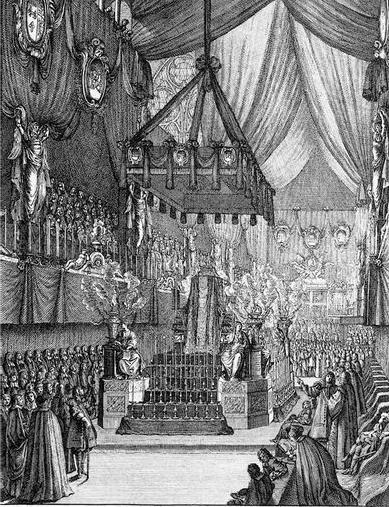
Since she had said it herself as well, rumours of poison and who might have done such a vile deed ruled the day. It was not difficult to find someone to blame. After all, Madame was behind the exile of the Chevalier de Lorraine and he must have poisoned her as revenge. There was only one small problem with that… the Chevalier was still in Rome. Thus, so people said, he must have commanded someone to meet him there, probably that Monsieur Morel he was friends with, and that Morel must have then received a poison from him, which he then took to Paris. The Italians are famous for their poisons, are they not? He could have also sent the poison to France with some souvenirs, well disguised, of course. But who then gave it to Madame? It must have been the Marquis d’Effiat, without a doubt. And since the dog drank the rest of the water and did not fall ill, d’Effiat must not have poisoned the water itself… but the cup. Madame always drank from the same cup, everyone knew that.
To make an end to all of that talk, which also endangered the relationship of France and England, Louis XIV ordered an autopsy should be preformed. The results were published in the Gazette, for everyone to see, and said that the Duchesse d’Orléans sudden demise was due to a colic, the stomach reportedly full of fermented bile and the organs in a state of advanced gangrene. This autopsy was preformed by the best French physicians and an English surgeon, with many onlookers observing every step of it, but it did only little to shut down the rumours.
The talk of Madame having been poisoned by the Chevalier de Lorraine and his clique lives on until today. Some said Monsieur was in the know, some said he was not, but all agreed it was an act of revenge. Today, some claim it might have been a slow arsenic poisoning that was the reason of her demise, but it is much more likely that it were actual natural causes. Madame was never really in good health and what seemed to be a sudden illness, probably was one she had for long years already and ended with her demise. Minette always had been thin, close to undernourished, and hyperactive, which could mean she suffered of anorexia nervosa. Gui Patin, a court doctor, believed she also had tuberculosis. All of that is of course not good for various organs and can lead to their failure. Monsieur Vallot, one of her doctors, thought it a miracle that she had actually lived that long considering all the different medical issues she complained about since her youth.
Minette’s body was embalmed and brought to Saint-Denis on July 4, to lay in state until August 21 until she was put to rest, with great pomp: “Last of all came the members of Monsieur and Madame’s household, bearing torches in their hands. A mausoleum, surrounded with altars and silver urns, and adorned with a crowd of mourning allegorical statues, among which Youth, Poetry and Music were conspicuous, had been erected in the centre of the choir. There the coffin rested, covered with cloth of gold, edged with ermine, and embroidered with the arms of France and England in gold and silver. Everyone having taken their places hundreds of candles burst into flame giving a cloud of incense; and the Archbishop of Reims assisted by other bishops, began the Mass, which was chanted by the King’s musicians organised by Lully.” The funeral oration by Jacques-Bénigne Bossuet moved many of those present to tears.
